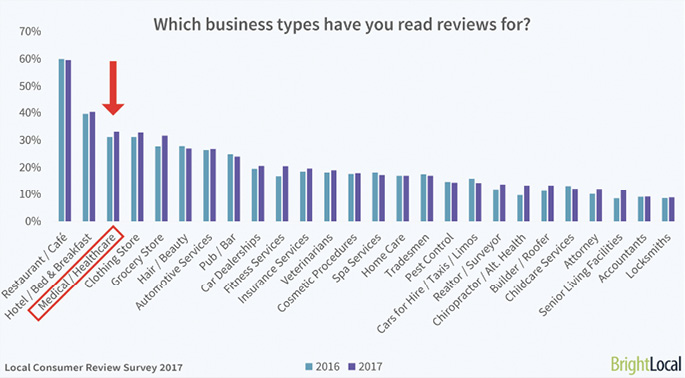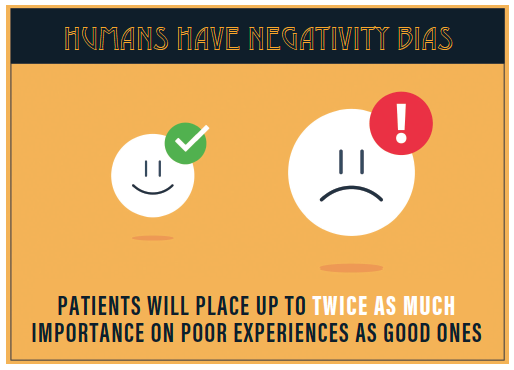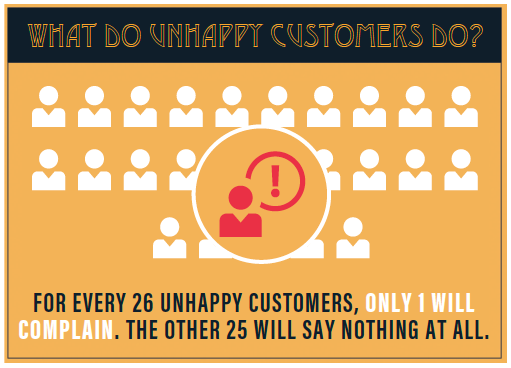
A patient or a customer? Should we think of our patients purely as recipients of health care, or are they also our customers? Of course, they are both.
When patients arrive at your clinic or hospital, they do not leave behind their knowledge of being a consumer. Neither they nor their family members discard the experiences they have had as social media users, Tweeters, Instagrammers, or regular users of websites such as Amazon, Yelp, or the online business review website Trustpilot.1 After choosing their hotel based on its five-star reviews on TripAdvisor, they won’t forget the attention they got at the Ritz-Carlton or Marriott.
Health care tends to be rather isolated and inward-looking. Among doctors and other providers of health care, there is a strong tendency to compare ourselves only to the clinic down the road or other local competitors. This is both a mistake and a lost opportunity. If you benchmark only against others in the industry and aim for customer service as many health care providers offer it, you risk setting your standards too low.
Your patient will judge the level of customer service you provide against the best service they have experienced in other places, including service-led industries that have mastered the art of providing outstanding customer care.
Technology and connectedness have raced ahead, with expectations following immediately behind. Patience is no longer a virtue for today’s patients. They live in a world of Prime Now, where they can shop for pretty much whatever they might need and have it delivered to their homes—on the same day. Alexa can tell them whatever they need to know—immediately.
In health care, though, we think that it’s OK to get back to the patient in a couple of days with the answer to that question. We’ll send the lab results next week.
But nothing takes a week—not anymore.
HEALTH CARE IS A BUSINESS
There is no getting away from the fact that private health care is a business. There is also a good argument that health care is not like other businesses, and patients are unlike other kinds of customers. Patients are not customers in the traditional sense; many health care consumers lack the knowledge and perspective to make informed decisions, and someone having a heart attack can’t shop around.2
Retail customers traditionally are in good health, and their ability to buy goods or services gives them power. Patients in a hospital setting are often unwell. They can be vulnerable, scared, in pain, tired, and confused, because of either their conditions or the medications used to treat them.
However, refractive surgery is elective treatment on healthy people, and this is an area in which many aspects of being a retail consumer still apply. Laser or lens surgery takes place in a walk-in, walk-out, keep-your-clothes-on scenario that is removed from the vulnerable inpatient experience. Our refractive surgery consumer-patients will expect care and customer service beyond what they would tolerate in a hospital when unwell. And their expectations are rising (which is a good thing).
Micah Solomon, a consultant and thought leader on customer service, has advised that consumers “expect the white-glove treatment long after you’ve closed the deal.” And, he continues, citing the Harvard Business Review, “it can be anywhere from five to 25 times more expensive to acquire a new customer than to retain an existing one.”3
In refractive surgery, taking exceptional care of the patient all the way down the line is not just the right thing to do, it is also vital to growing your practice through word of mouth.
SHIFTING BALANCE OF POWER
Back in the early 1990s, when Amazon was just a river (the company of that name started in 1994), people began taking the internet, and the wealth of information it liberated, seriously. The rise of the internet gave people power that they had never experienced before; they could educate themselves, share their thoughts, and for the first time share feedback on a wide stage.
We take this for granted now, but in the 90s it wasn’t so obvious. Most people didn’t see what was coming. Among the exceptions were Christopher Locke, Rick Levine, Doc Searls, and David Weinberger, who, in 2000, wrote The Cluetrain Manifesto: The End of Business as Usual. Ahead of its time, this book foresaw the internet’s dramatic impact on how companies would interact with their employees, customers, and the market.4
At its core, the authors said, “markets are conversations.” Mass marketing was being replaced by digital media that allowed discussions among consumers and between consumers and companies. This has indeed transformed how traditional businesses operate, even if health care is a laggard to the party.
Today’s patients have more information, resources, and options than ever before. Thanks to online reviews, influencers, social media, and the broader internet, patients arrive at your door with at least a little bit—and sometimes a lot—of information on your clinic, your treatments, your competitors, and the profession and industry in general.5 Patients’ first point of call is now often Google rather than their doctors. If they didn’t like what they found out about you online, they wouldn’t even make it to your door.
A KEY TOOL
Your website is your key tool, and it had better work hard on your behalf. Along with review sites, it’s the primary place that patients go to get a first impression, and you’ve got only a few seconds to make an impression before they depart for your competitor’s site.
If your site is outdated or hard to navigate, patients won’t work hard to give you a second chance—they’ll just leave. If your website isn’t mobile-responsive, you’re in big trouble; it will give visitors a poor user experience and generate high traffic bounce rates on mobile devices. To compound this problem, Google has implemented mobile-first indexing.6
If your website isn’t all of these things, stop reading now and go fix it. You don’t have time to finish this article yet!
THE RISE OF REVIEW SITES
Back in the Amazon-was-just-a-river era, it wasn’t easy for information to spread about how a company treated its customers. Sites like Yelp or Trustpilot (Figure 1),1 where customers could share their stories about when they were poorly treated, didn’t exist. Companies could provide appallingly poor levels of customer service without fear of backlash.

Figure 1. The eye treatment category on the website Trustpilot, accessed May 12, 2018.
Before information was readily available online, buyers also had to rely 100% on what sellers said about their products. There were no places that aggregated product information or customer feedback, so buyers either had to rely on their personal networks for recommendations or take companies at their word.
Architect Frank Lloyd Wright’s grimly humorous quote, “The physician can bury his mistakes—but the architect can only advise his client to plant vines,” bears remembering. Fortunately, poor outcomes or follow-up care can no longer be hidden; this is good news for the evolution of health care because it drives up standards.
Professions like ours, however, have remained stubbornly resistant to pulling back the curtain on dedicated patient feedback. Revealingly, a study by the Manhattan Institute for Policy Research of New York State hospital ratings given on Yelp—a website with a remarkable 140 million unique monthly users—found that better reviews were correlated with better medical care.7
There are now thousands of aggregation sites for reviews. Information about providers is everywhere; patients demand far more from their doctors, clinics, and hospitals because they can. Any patient (or even employee) can use the web to communicate in a moment with thousands of others.
If a story goes viral, its reach can extend to millions through the national news media, as happened in Baltimore when the University of Maryland Medical Center was forced to apologize to a patient who was found on the street in the middle of winter wearing only a thin hospital gown and socks after being ejected by security.8
Unhappy patients can quickly let lots of other prospective patients know what they think about your care or service. The same goes for your disgruntled employees. You can’t control what people say about you, so you’d better deliver a remarkably high level of service and care to ensure that the news (even the national news!) is good.
Your company voice must be honest and genuine, and that begins with your website. Your online portal must demonstrate your honesty, integrity, and sincere interest in the care of your patients. Your site is the first port of call in building trust with prospective patients.
Note, however, that the appearance of caring, if not backed by your actions in the clinic, especially during follow-up care when the fees have already been paid, will quickly be revealed as a sham. The long-term conversations you seek to build trust and rapport will not be sustained. As the authors of the Cluetrain Manifesto foresaw, when “markets are conversations,” only genuine, consistent customer service will suffice.
PROTECT YOUR BRAND
A company’s online reputation is now one of its most prized assets. When you search for a local business, online reviews invariably appear. Google now shows reviews in many search engine results pages, and it also includes third-party sites in a business’s knowledge panel.
Potential patients can’t help but be confronted with reviews about your services (Figure 2), be they good, bad, or cringe-worthy ugly. What will succeed in the future must be different from what went before. Those who will win in their sector must have mastered providing customers with a good experience and innovated how they dispense service throughout the patient journey. The customer is, once again, monarch, and that’s good for doctors, clinics and, most of all, patients.

Figure 2. Result of BrightLocal consumer review surveys from 2016 (blue) and 2017 (purple).
WHAT IS CUSTOMER EXPERIENCE?
Customer experience (CX) is your customers’ perception of how you treat them. It is defined by the customer and not by your intent: If they think you messed up, then you messed up. These perceptions sculpt the customers’ actions, memories, and emotions.
If you get it right, they will be loyal to your brand and spread positive stories. Simply put, if they like you and you consistently deliver, they are going to choose you for their treatment and recommend you to others. If you amaze and wow them, they will evangelize you and your clinic.
Esteban Kolsky, CEO of ThinkJar and formerly an analyst at the business advisory company Gartner, conducted a CX survey and reported some revealing findings: Among customers who are not satisfied with their CX, 13% will tell 15 or more people that they are unhappy. Flip the coin over, and 72% will share a positive experience with at least six other people.9
But surely you’ll know if you are getting things wrong. No, you won’t. The silent majority of customers will not complain (to the practitioner) when they have had a bad experience.
Remember that humans have a considerable negativity bias; we take note of and remember negative experiences and information up to twice as well as positive information of the same degree (see Humans Have Negativity Bias).

Unhappy customers who don’t complain in person often head elsewhere for treatment or a second opinion. There is a good chance that they will spread negative comments, both in person and online. You need to actively monitor social media channels with tools like Hootsuite Insights and Google Alerts, among many other available tools.
Social media have taken over—the total time spent on social media exceeds time spent eating and drinking, socializing, and grooming.10 Like a double-edged sword, it has created new opportunities for customers to sing your praises or to tell the world of your shortcomings.
Kolsky’s findings include the following:
- In total, 66% of consumers who switched loyalties did so due to unsatisfactory service;
- About 85% of customer loss due to poor service was avoidable; and
- A total of 70% of companies that deliver best-in-class CX use customer feedback, compared with an industry average of 50%, and 29% for laggards.9
- Two-thirds of customers note bad experiences as a reason for leaving, but only one out of 26 unhappy customers complain (see What Do Unhappy Customers Do?) and the rest just leave.

The take-home message is that the absence of negative feedback in the moment is not necessarily a sign of a happy customer. They don’t need to tell you—they can vent to an online world that is ready to listen, respond, and share.
It has become clear that, to deliver an outstanding CX—to create that wow effect—you have to understand your customers better than ever before. You need to monitor and assess your customers’ behaviors at every point of contact, across multiple channels online, as well as in the clinic.
Then you must use that knowledge to personalize each interaction. If you make sure their experiences with your practice are smooth, enjoyable, and continually improving through actively acquired feedback, you will gain loyal customers. If not, you’ll delight your competitors by giving them the best gift—your patients.
CX: KEY BRAND DIFFERENTIATOR
According to a study by the consulting firm Walker, by 2020, CX will overtake price and product as the key brand differentiator.11 In the years ahead, customers will expect companies to know their individual needs and to personalize their experience to match.12 Interestingly, the Walker study showed that 86% of consumers are willing to spend more for a better CX.
Alex Allwood is CEO of the Holla Agency and the author of Customer Experience is the Brand.13 As she has said, “Today’s marketplace has become very competitive and commoditized. CX encompasses a number of things, customer service being one of them. But essentially it is any interaction a consumer has with an organization and the perception of how a company treats them.”12
In refractive surgery, with laser platforms keeping pace with one another for technology, approach, and results, and lens implants available to all, what will differentiate you from your competitors? Of course, a well-known, reputable surgeon will always be a powerful influencer. As noted in the Cluetrain Manifesto, patients will first assess the doctor’s performance from the array of reviews available and the online conversations taking place on social media.
the end of deep discounts
We have also, thankfully, left behind the damaging era of deep discounts on laser eye surgery, and most providers now set their prices within a comparable range. Realistic fees mean better patient care, quality, and technology.
In Allwood’s words,12 “There is little differentiation between one brand and the next. And so if you are already competing on price, technology, or innovation, what is going to differentiate you from your competitors? What is going to be your point of difference? That comes down to how your customer experiences the brand, and how that brand makes a person feel.”
The bottom line
In short, your company should strive to create an experience that your customers—your patients—can identify with and want to share with others. If you can achieve this, then your patients will be loyal to your brand, continue their care at your practice, and recommend your practice to others. The bottom line is that CX has become the greatest differentiator from one brand to the next.
1. Trustpilot. Eye Treatment result. https://uk.trustpilot.com/categories/eye_treatment. Accessed May 15, 2018.
2. Torpie K. Customer service vs. patient care. Patient Experience Journal. 2014;1(2):6-8.
3. Solomon M. Improving the hospital patient customer experience (It’s about more than HCAHPS scores). Forbes. December 20, 2013.
4. Levine R, Locke C, Searls D, Weinberger D. The Cluetrain Manifesto. New York: Basic Books. 2009.
5. Campbell D. Four ways power has shifted to the buyer (and what sales can do to adapt). The Whole Brain Group. May 16, 2017. http://blog.thewholebraingroup.com/4-ways-power-has-shifted-to-the-buyer-and-what-sales-can-do-to-adapt. Accessed May 15, 2018.
6. Rolling out mobile-first indexing. Google Webmaster Central Blog. March 26, 2018. https://webmasters.googleblog.com/2018/03/rolling-out-mobile-first-indexing.html. Accessed May 15, 2018.
7. Howard P, Feyman Y. Yelp for health: using the wisdom of crowds to find high-quality hospitals. Manhattan Institute for Policy Research. April 12, 2017.
https://www.manhattan-institute.org/html/yelp-health-using-wisdom-crowds-find-high-quality-hospitals-10186.html. Accessed May 15, 2018.
8. Moyer JW. Video shows apparently incapacitated, half-naked woman put out in cold by Baltimore hospital. Washington Post. January 10, 2018.
9. Afshar V. 50 Important Customer Experience Stats for Business Leaders. Huffington Post Blog. December 6, 2017. www.huffingtonpost.com/vala-afshar/50-important-customer-exp_b_8295772.html. Accessed May 15, 2018.
10. Asano E. How Much Time Do People Spend on Social Media? Social Media Today. January 4, 2017. www.socialmediatoday.com/marketing/how-much-time-do-people-spend-social-media-infographic. Accessed May 15, 2018.
11. Customers 2020: A Progress Report. 2017. www.walkerinfo.com/knowledge-center/featured-research-reports/customers2020-1. Accessed May 15, 2018.
12. [no author listed] Customer experience – the new competitive battleground. The Guardian [paid content]. www.theguardian.com/ing-direct-being-human-in-a-digital-world/2016/dec/22/customer-experience-the-new-competitive-battleground. Accessed May 15, 2018.
13. Allwood A. Customer Experience is the Brand. Surrey Hills, Victoria, Australia: Michael Hanrahan Publishing; 2015.




